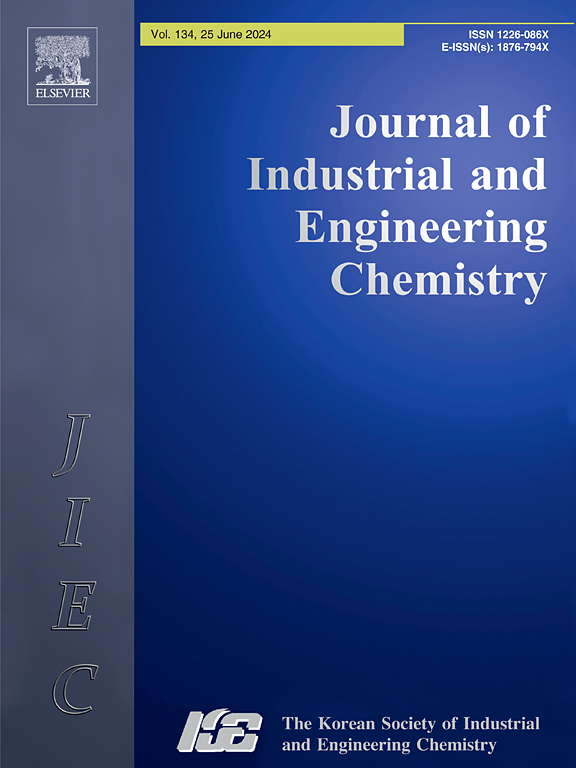镍在可持续 POFA 衍生 SBA-15 上的合成、表征和催化性能,用于甲烷二氧化碳重整产生的富氢合成气
IF 5.9
3区 工程技术
Q1 CHEMISTRY, MULTIDISCIPLINARY
Journal of Industrial and Engineering Chemistry
Pub Date : 2025-01-25
DOI:10.1016/j.jiec.2024.06.021
引用次数: 0
摘要
全世界许多棕榈油厂都在大量生产棕榈油燃料灰(POFA),造成了环境废物处理问题。值得注意的是,棕榈油燃料灰是一种具有成本效益的替代硅源,可替代昂贵的正硅酸四乙酯(TEOS)。本研究的重点是利用 POFA 废弃物合成 SBA-15,并考察促进剂对 POFA 衍生 SBA-15 支持的镍基催化剂的影响。在 10 wt% Ni/SBA-15-POFA 催化剂中依次浸渍了 Zr、Ce、La 和 Cr 等负载量为 1 wt% 的促进剂。催化剂在 800 °C 下进行了 8 小时的一氧化碳甲烷重整(CMR)测试,同时保持了化学计量进料比。采用了各种表征技术,包括 XRD、FESEM、XPS、H-TPR、CO-TPD 和 BET 分析,以评估催化剂的理化性质。促进剂的添加改变了催化剂的性质。除铬促进催化剂外,促进剂的添加对催化性能、活性和稳定性都有积极影响。XRD 分析表明,铬的添加对 Ni/SBA-15-POFA 催化剂的晶粒结构有不利影响。相比之下,添加 Zr、Ce 和 La 能显著减小晶粒尺寸,改善活性金属的分散性。总体而言,Zr 促进的催化剂在活性和稳定性方面表现最佳,CH 转化率为 90%,CO 转化率为 94.4%。废催化剂表征(包括 XRD、FESEM、O-TPO 和 RAMAN)表明,添加促进剂可显著减少碳沉积。Zr 促进催化剂的稳定和优异性能归功于 MWCNTs 的产生。相反,未添加促进剂的催化剂会迅速失活,这可能是由于无定形碳的形成,无定形碳会迅速阻塞活性位点,降低催化活性。本文章由计算机程序翻译,如有差异,请以英文原文为准。
Synthesis, characterization, and catalytic performance of Ni supported on sustainable POFA-derived SBA-15 for hydrogen-rich syngas from CO2 reforming of methane
Palm Oil Fuel Ash (POFA) is massively produced by numerous palm oil mills worldwide, creating an environmental waste disposal problem. Notably, POFA serves as a cost-effective alternative silica source instead of the expensive tetraethyl orthosilicate (TEOS). This research focused on synthesizing SBA-15 from POFA waste and examining the effect of promoters on POFA-derived SBA-15-supported Ni-based catalysts. The 10 wt% Ni/SBA-15-POFA catalyst was sequentially impregnated with promoters having 1 wt% loading of Zr, Ce, La, and Cr. The catalysts were tested for CO2 methane reforming (CMR) at 800 °C for 8 hours while maintaining a stoichiometric feed ratio. Various characterization techniques, including XRD, FESEM, XPS, H2-TPR, CO2-TPD, and BET analysis were employed to assess the catalyst physicochemical properties. The addition of promoter changed the properties of catalyst. Except for Cr-promoted catalyst, the addition of promoters positively impacted catalytic performance, activity, and stability. XRD analysis showed that Cr addition had detrimental effects on the crystallite structure of the Ni/SBA-15-POFA catalyst. In contrast, Zr, Ce, and La additions significantly reduced the crystallite size and improved active metal dispersion. Overall, the Zr-promoted catalyst exhibited the best performance in terms of activity and stability, with a CH4 conversion of 90 % and CO2 conversion of 94.4 %. The spent catalyst characterization, including XRD, FESEM, O2-TPO, and RAMAN, showed that promoter addition significantly reduced carbon deposition. The stable and superior perfromance of Zr-promoted catalyst was attributed to the production of MWCNTs. Conversely, the rapid deactivation of the unpromoted catalyst may be due to the formation of amorphous carbon, which tends to quickly block active sites and reduce the catalytic activity.
求助全文
通过发布文献求助,成功后即可免费获取论文全文。
去求助
来源期刊
CiteScore
10.40
自引率
6.60%
发文量
639
审稿时长
29 days
期刊介绍:
Journal of Industrial and Engineering Chemistry is published monthly in English by the Korean Society of Industrial and Engineering Chemistry. JIEC brings together multidisciplinary interests in one journal and is to disseminate information on all aspects of research and development in industrial and engineering chemistry. Contributions in the form of research articles, short communications, notes and reviews are considered for publication. The editors welcome original contributions that have not been and are not to be published elsewhere. Instruction to authors and a manuscript submissions form are printed at the end of each issue. Bulk reprints of individual articles can be ordered. This publication is partially supported by Korea Research Foundation and the Korean Federation of Science and Technology Societies.

 求助内容:
求助内容: 应助结果提醒方式:
应助结果提醒方式:


